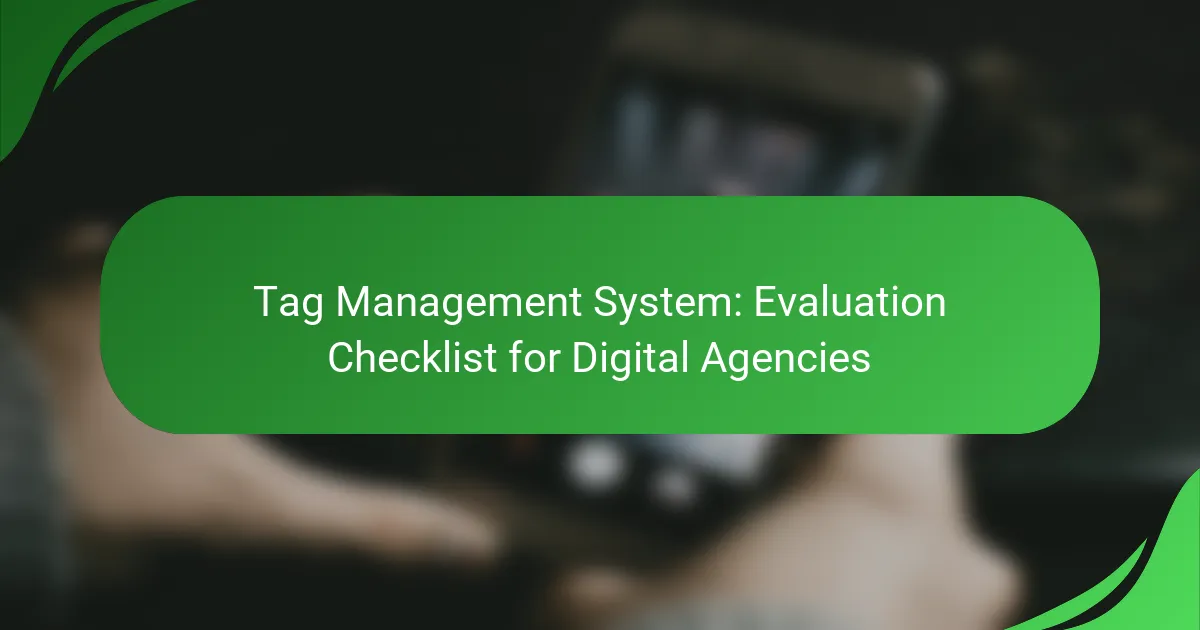Tag management systems (TMS) are crucial for managing marketing tags in international campaigns, providing features that streamline deployment across various regions. These systems enhance user experience, optimize data collection, and ensure compliance with local regulations, making campaigns more efficient and responsive to market needs.

What are the key features of tag management systems for international campaigns?
Tag management systems (TMS) designed for international campaigns offer essential features that facilitate the management and deployment of marketing tags across multiple regions. These features enhance user experience, optimize data collection, and ensure compliance with local regulations.
Multi-language support
Multi-language support is crucial for international campaigns as it allows tags to be customized based on the user’s language preference. This feature ensures that content is relevant and accessible, improving engagement rates across diverse markets.
When implementing multi-language support, consider using language detection tools to automatically serve the appropriate version of your tags. This can significantly enhance user experience and conversion rates.
Geolocation targeting
Geolocation targeting enables marketers to deliver personalized content based on the user’s geographic location. This feature helps in tailoring messages and offers that resonate with local audiences, increasing the effectiveness of campaigns.
To implement geolocation targeting, utilize IP address tracking or GPS data to identify user locations. Ensure compliance with local privacy regulations when collecting and using location data.
Customizable tags
Customizable tags allow marketers to create specific tags that cater to unique campaign needs. This flexibility is essential for adapting to different market conditions and consumer behaviors across regions.
Consider using a tag management system that offers a user-friendly interface for creating and modifying tags without extensive coding knowledge. This can streamline the process and reduce reliance on IT resources.
Integration with analytics tools
Integration with analytics tools is vital for tracking campaign performance and user behavior across different markets. A robust TMS should seamlessly connect with popular analytics platforms, enabling comprehensive data analysis.
When selecting a TMS, ensure it supports integration with tools like Google Analytics, Adobe Analytics, or local analytics solutions relevant to your target regions. This will provide deeper insights into campaign effectiveness.
Real-time updates
Real-time updates allow marketers to make immediate changes to tags without requiring a full redeployment. This feature is particularly useful for responding quickly to market trends or compliance changes in different countries.
Choose a TMS that supports real-time updates to ensure your tags are always current. This capability can help mitigate risks associated with outdated tags and improve overall campaign agility.

How do tag management systems enhance display advertising?
Tag management systems (TMS) streamline the process of managing and deploying marketing tags, which significantly enhances display advertising. By simplifying tag implementation, they improve ad performance, targeting accuracy, and overall campaign efficiency.
Improved ad targeting
Tag management systems enable precise ad targeting by allowing marketers to collect and analyze user data more effectively. This data can include demographics, browsing behavior, and location, which helps in creating tailored ads that resonate with specific audience segments.
For instance, a TMS can facilitate the use of retargeting tags that display ads to users who have previously interacted with a brand’s website. This increases the likelihood of conversions by reminding potential customers of their interest.
Faster campaign deployment
With a tag management system, marketers can deploy campaigns much faster by eliminating the need for extensive coding. Changes to tags can be made through a user-friendly interface, allowing for quick updates and new tag additions without involving IT teams.
This agility is crucial for time-sensitive campaigns, such as seasonal promotions or flash sales, where speed can directly impact revenue. Marketers can launch campaigns within hours instead of days, maximizing their reach and effectiveness.
Data-driven decision making
Tag management systems provide valuable insights through comprehensive data collection and reporting capabilities. By analyzing this data, marketers can make informed decisions about ad placements, budgets, and strategies to optimize campaign performance.
For example, a TMS can track which ads perform best across different regions or demographics, allowing marketers to allocate resources more effectively. Regularly reviewing this data helps in adjusting campaigns in real-time, ensuring better ROI.

What are the benefits of using a tag management system in Canada?
Using a tag management system (TMS) in Canada streamlines the process of managing marketing and analytics tags, enhancing efficiency and compliance. It allows businesses to quickly implement changes without extensive IT involvement, ensuring that campaigns are agile and responsive to local market needs.
Compliance with local regulations
A TMS helps Canadian businesses adhere to local regulations such as the Personal Information Protection and Electronic Documents Act (PIPEDA). By managing tags centrally, companies can ensure that data collection practices are transparent and compliant with privacy laws.
Moreover, a TMS can facilitate the implementation of consent management tools, allowing users to easily opt in or out of data tracking. This not only meets regulatory requirements but also builds trust with customers, which is crucial in the Canadian market.
Optimized user experience
Implementing a TMS can significantly enhance the user experience by reducing page load times. By asynchronously loading tags, businesses can ensure that essential content is prioritized, leading to faster interactions for users.
Additionally, a TMS allows for A/B testing and personalization without heavy reliance on developers. This flexibility enables marketers to tailor experiences based on user behavior, preferences, and demographics, ultimately improving engagement and conversion rates.
Enhanced performance tracking
A tag management system provides robust tools for tracking the performance of marketing campaigns. It allows businesses to easily implement and manage tracking codes for various platforms, ensuring accurate data collection across channels.
With real-time data access, companies can quickly analyze campaign effectiveness and make informed decisions. This agility is essential for optimizing marketing strategies and maximizing return on investment in the competitive Canadian landscape.

What criteria should be considered when selecting a tag management system?
When selecting a tag management system (TMS), consider scalability, ease of use, and cost-effectiveness. These factors will ensure that the system can support your international marketing efforts efficiently and effectively.
Scalability for global reach
A scalable tag management system allows businesses to manage multiple tags across various regions without performance issues. Look for a TMS that can handle increased traffic and additional tags as your campaigns expand globally.
Consider systems that offer features like automated tag deployment and real-time updates, which can save time and reduce errors as you scale. This is particularly important for companies operating in diverse markets with varying regulatory requirements.
Ease of use
Ease of use is crucial for a tag management system, especially for teams that may not have extensive technical expertise. A user-friendly interface with drag-and-drop functionality can significantly streamline the process of managing tags.
Additionally, look for systems that provide comprehensive documentation and support resources. This will help your team quickly adapt to the TMS, minimizing the learning curve and allowing for faster implementation of international campaigns.
Cost-effectiveness
Cost-effectiveness is a key consideration when choosing a tag management system, as it impacts your overall marketing budget. Evaluate the pricing models of different TMS options, including subscription fees and potential additional costs for support or advanced features.
Compare the total cost of ownership, factoring in the potential savings from improved efficiency and reduced reliance on IT resources. A system that offers a good balance between features and affordability will provide the best return on investment for your international campaigns.

What are the common challenges in implementing tag management systems?
Implementing tag management systems (TMS) can present several challenges that organizations must navigate. These challenges often include integration issues, data privacy concerns, and the need for adequate training and support.
Integration issues
Integration issues arise when a tag management system must connect with various platforms, such as content management systems, analytics tools, and marketing software. Compatibility problems can lead to delays and increased costs, especially if custom development is required.
To mitigate integration challenges, organizations should conduct a thorough assessment of existing systems before implementation. It’s advisable to choose a TMS that offers pre-built integrations with commonly used tools to streamline the process.
Data privacy concerns
Data privacy concerns are critical when implementing a tag management system, particularly in regions with strict regulations like the EU’s GDPR. Organizations must ensure that the tags deployed do not compromise user data or violate privacy laws.
To address these concerns, it’s essential to implement robust data governance practices. Regular audits of tags and their data collection methods can help maintain compliance and build trust with users.
Training and support needs
Training and support needs can be significant barriers to the successful implementation of a tag management system. Teams may require extensive training to effectively use the TMS and understand its features.
Providing comprehensive training sessions and ongoing support can enhance user proficiency. Consider creating a knowledge base or utilizing online resources to assist users in navigating the system efficiently.

How do tag management systems compare to traditional methods?
Tag management systems (TMS) streamline the process of managing and deploying marketing tags compared to traditional methods, which often involve manual coding. TMS allows marketers to implement changes quickly and efficiently without needing extensive IT support, reducing time-to-market for campaigns.
Efficiency and Speed
Tag management systems significantly enhance efficiency by enabling marketers to deploy tags without direct coding. This results in faster implementation, often within minutes, compared to traditional methods that may take days or weeks due to the need for developer involvement.
With a TMS, users can manage multiple tags from a single interface, which simplifies updates and troubleshooting. This centralized control reduces the risk of errors and ensures that tags are consistently applied across various platforms.
Flexibility and Control
Using a tag management system offers greater flexibility in managing tags. Marketers can quickly add, edit, or remove tags as needed, allowing for real-time adjustments to campaigns based on performance data. This level of control is often lacking in traditional methods, where changes require more extensive processes.
Additionally, TMS platforms often support version control, enabling users to revert to previous tag configurations if necessary. This feature is particularly useful for international campaigns that may require frequent adjustments to comply with local regulations or market conditions.
Cost Considerations
While traditional methods may incur higher costs due to the need for ongoing developer resources, tag management systems can reduce these expenses significantly. Many TMS solutions operate on a subscription model, which can be more budget-friendly for businesses, especially small to medium enterprises.
However, it’s essential to evaluate the total cost of ownership, including potential training for staff and any additional features that may incur extra fees. Businesses should consider their specific needs and the scale of their campaigns when selecting a TMS to ensure it aligns with their budget.



